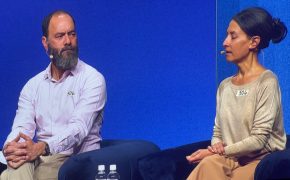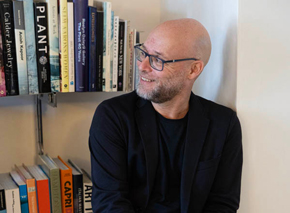Shabbat Ki Tavo
Two Mountains
 After two weeks of the most important laws of the Torah, Moses now turns towards what to do when they enter the land of Israel. The first command concerns first fruits. In bringing the produce of this new land, they make this declaration that refers to their origins, experience of slavery in Egypt and now having come to a land of their own and having produced their new harvest they were to dedicate them to God in gratitude.
After two weeks of the most important laws of the Torah, Moses now turns towards what to do when they enter the land of Israel. The first command concerns first fruits. In bringing the produce of this new land, they make this declaration that refers to their origins, experience of slavery in Egypt and now having come to a land of their own and having produced their new harvest they were to dedicate them to God in gratitude.
The Torah specifies that we should take them to “the place which God has chosen to be the repository of his name” which was taken to mean the Tabernacle ( which then in due course it would be transferred into a permanent temple ). But it doesn’t specify where that place would be, and we know that when they came into the land of Canaan, the Tabernacle moved from place to place , and one stage was captured by the Philistines before finally coming to rest in Jerusalem.
Then, the Torah commands them to erect two stone tablets and cover them with plaster, onto which the laws of the Torah would be written for all to see. This is an important signal that the law had to be accessible to everyone.
This would be followed by a public ceremony that would take place on the West Bank at two mountains, Gerizim for the blessings, and curses on Eyval. The tribes would be divided into two, with half on one and the other half on the other. In between them the priests would stand, and they would turn to one mountain and describe the blessings that would be granted if the children of Israel were true to their heritage. And then turn to the other and describe the curses that would happen to those who abandoned them.
The curses consist of a list of very specific short laws for the curses. And a very general but much longer list of the blessings. Two very distinct declarations in style and content. The curses include not respecting one’s parents. Not removing boundaries (defining private property) not misleading others, not distorting justice, not taking advantage of strangers, orphans and widows, a list of forbidden sexuality, respecting one’s neighbors and friends. And a general statement about disobeying the Torah.
I do not like the translations of blessings and curses. Rather, good things or bad things will happen depending on their behaviour. But what was the point of repeating those specific commands once again? All of them are things that are done secretly, in the privacy of one’s home, things that are not normally detectable and could often be disguised. The Torah emphasises that for a country and a people or community to function effectively the laws are not enough. The spirit of the law is what matters and the relationship between people is what will bring blessing as opposed to what will bring curses. All of this, of course, is particularly relevant to the world in which we live today, where there is so much conflict and tension.
Returning to the two mountains Gerizim and Eyval. King David conquered Jerusalem roughly speaking 3000 years ago and his son Solomon built the temple there. Why was no temple built on Mount Gerizim which was specified in the Torah? Some 300 later, the country split into two kingdoms, Judah in the South and Israel in the north. In 720 BCE the north was destroyed by the Assyrians and its inhabitants exiled and scattered around the empire which extended from the Euphrates eastwards. Other peoples defeated by the Assyrians were then resettled in that conquered territory to make sure that the original inhabitants would not re-constitute.
According to our Bible, other conquered people settled in the north, Samaria and became known as Samaritans. And they adopted the Torah as their religious authority but built their temple on Mount Gerizim in the north. Which, by the way is strange, because the Torah said that the altar and sacrifices should be on Mount Eyval! But that’s their problem.
150 years later the Judeans were exiled by the Babylonians. But they were not scattered and established a vibrant community. This was why thanks to the Persian kings Cyrus and later Darius some Jews could return to rebuild the temple in Jerusalem. And they brought with them traditions and interpretations from Babylon that were added to the written law. The Samaritans saw the returning Judeans as a threat and refused to accept them and the Oral law that was to become Talmud. But the Judeans survived and thrived.
The Samaritan version of their origins is different to ours in that they claim they were the remnant of the Ten Lost Tribes of the North who managed to hide from the Assyrians and when the threat was over, reconstituted the community in the absence of the Judeans. The rivalry between the Jews and the Samaritans continued until the Roman exile, sometimes close and sometimes distant.
Mount Gerizim which is near Nablus on the West Bank, remains their holy place to this day even though their temple was destroyed by the Maccabean King John Hyrcanus, and later by the Byzantian Christians. To this day there are still small communities of Samaritans in Samaria as well as settlements in Holon in Israel and in parts of America.
But to be fair, and fanciful, it might seem from this week’s Torah that their choice of Holy Mountain was more authentic than ours!
Rabbi Jeremy Rosen lives in New York. He was born in Manchester. His writings are concerned with religion, culture, history and current affairs – anything he finds interesting or relevant. They are designed to entertain and to stimulate. Disagreement is always welcome.







